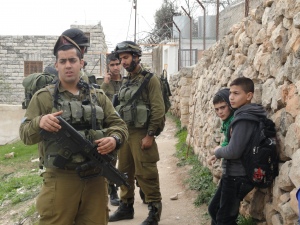httpv://youtu.be/PDaMlJVcMkA
According to a report by the Ecumenical Accompaniment Programme in Palestine and Israel (EAPPI), on Wednesday, March 20, at 7:30 am, the day President Obama landed in Tel Aviv, 22 Israeli soldiers arrived at the Hebron Public Elementary School where they forced schoolchildren to walk to Checkpoint 29 and then into military vehicles. In total, the Israeli Military apprehended 27 minors, ages 7-15 during this incident. An international protester took the video above. According to BtSelem, an Israeli human rights group, 14 were under the age of 12. It is illegal to detain Israeli children under the age of 12, but the occupied Palestinian territories are subject to a different set of laws through the Israeli military.
Though reports of the details differ, according to the EAPPI report:
– two of the children were released on the side of a road shortly after being detained. The remaining 25 children were taken to the police station near the Ibrahimi Mosque, where they were photographed and had their fingerprints taken. Teachers from the school went to the police station but were not allowed to enter.
– At 2:00PM the soldiers released the 8 youngest children, and continued to detain the remaining 17, who are all between the ages of 13 and 15. After interrogating them at the police station the soldiers transported the 17 children to the Jabarah and Junaid military bases, where they continued to question them.
– Later that night soldiers released 14 of the remaining children. Three of the children, Muhamad Al-Razim, Muhamad Burqan and Muhamad Al-Fakhoury (ages 14-15) were transported to the Ofer Military Prison where they were still detained as of Wednesday, March 27.
– The minors were questioned, photographed and had their fingerprints taken multiple times without consent and without the presence of parents, legal guardians, lawyers or teachers. Moreover, throughout the incident, the children were held along with other adult detainees, one of which is a long-time contact of EAPPI, Issa Amro, who confirmed that the children were both blindfolded and handcuffed for extended periods while being detained in the police station.
Ynet reports that the IDF confirmed it had arrested Palestinian schoolchildren on Wednesday morning “due to recent stone-throwing incidents toward the security forces and citizens in the city.” The Israeli army added that seven children had been taken for police interrogation.
Under international law, children should be restrained only if they pose an imminent threat to themselves or to others, and all other means have been exhausted. They also are entitled to have a parent, guardian or lawyer present for the interrogations.
Also in Hebron that day, according to Reuters, dozens of children and adults marched through Hebron’s Shuhada Street to protest the American president’s visit. Hebron is a flashpoint of tension between the more than 150,000 Palestinians and the less than 1000 Israeli settlers who live in the city. Shudada Street has been closed since 1994, and parts of the Old City of Hebron, where Palestinians used to own houses and shops, have been either closed or taken over by settlers.
According to Ali Gharib, reporting for the Daily Beast from Hebron, the protesters wore cartoon Obama masks and spoke out against segregation of Palestinians and Israelis in the city. They were joined by international activists with t-shirts saying “I have a dream.”
See EAPPI action alert | See story in Huffington Post | See BtSelem report

